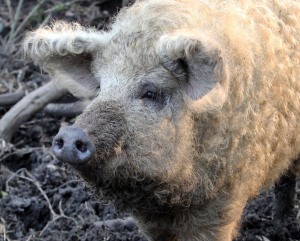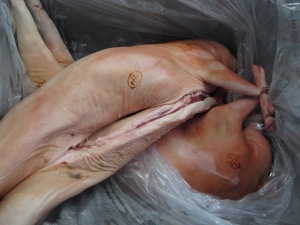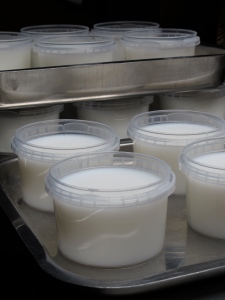Warning – ‘meaty’ post ahead.
I promised another blog post before the New Year, but to be honest this little ramble isn’t what I’d had in mind. I never did write fully about my experiences with our three Mangalitza, so I guess now is as good a time as any. I’ve been spurred by three things: firstly I’ve been offered some in-pig breeding stock, secondly on Christmas Eve I spent a couple of hours reviewing both our farm holding costs for rearing (post feed increases) and our basic cutting/production costs (based on the data I’ve collected from various carcasses over the year) and thirdly I saw some fab pictures of Mangalitza yesterday on the Pitt Cue Co twitter feed.
I had a happy relationship with our ‘Womble pigs’, they were quite out of the ordinary and all of our neighbouring farmers took a real interest in them. I initially thought that they’d see them as gimmicky but once I explained the reason why I was keeping them and the characteristics of the breed, I was quite surprised to see how interested people were in them. During the past two years I’ve lived a pretty intense Mangalitza existence, scouring the internet for information, reviewing academic papers, pouring through scientific analysis and meeting numerous breeders across more than one continent. I don’t do things by halves – people asked why I didn’t just start breeding, but I wanted to test the animals first before making that leap.
The culinary world in the US has a very strong appreciation for the breed, and prices for the animals (though they sound high) are pretty realistic. The norm that I saw last year was in the region of £12-£17 wholesale and up to £30 retail per kilo.
Few of the breeders that I met in the UK at the beginning of my journey are still breeding. High feed prices coupled by a difficult commercial carcass to sell makes the Mangalitza a very challenging beast. Having blogged and gained a few column inches about rearing Mangalitza myself, I get a call about every two weeks from a prospective breeder, or a fresh faced smallholder asking me for advice. This is my experience, you can make up your own mind…
I’ll start with the carcass – when you’ve got it on the block, it’ll be unlike any other pig you’ve cut. The muscle structure is far closer to a wild boar – large pronounced shoulders, small loins and leg muscles. Regardless of whether you have fat or lean Mangalitza you’ll probably wonder how they have enough muscle structure to stand up let alone root and run about the place. The tenderloin from a 100kg Mangalitza looks like a tenderloin from a 40kg traditional pig. As for meat quality, age has a definite influence. At 12 months although a deep red, it’s still an undeveloped meat. At 18 months, it’s claret red, rich and developed. I was a little disappointed with the marbling/intra-muscular fat – I’m probably spoilt as I’ve had a couple of Pedigree Welsh recently from older bloodlines that have had fantastic marbling. With any animal, it’s a combination – a balance of the right feed at the right time and the genetic characteristics of a particular bloodline. I really don’t know whether we have the right lines here in the UK to get the type of carcass that I’ve seen abroad and would dearly want to rear myself.
Now comes the challenging part: the fat. I’ve often been told by breeders that it’s not commercially viable as it’s too fatty an animal, so they try and cross-breed the animal or change the diet to reduce the level of fat. If you try and mess with the breed it won’t be a Mangalitza anymore. It’s a lard type animal, so it’s going to be fat. There’s two ways of looking at it – you can treat the animal in the same way as you would a more traditional pig and cost it on the % of usable meat or you find a use for all the fat, and make the animal work for you. This is my problem with the breed, it’s not a straightforward pig, and there needs to be a lot of work to try and get a decent carcass balance from the animal. I hate waste so we’ve had to experiment with a few different things to use up all the spare backfat we had from our three pigs – we still have around 12kg left in the freezer. As for the reality – although I’d seen carcasses, I’d never cut a Mangalitza myself, I was expecting fat but I wasn’t really expecting the levels of backfat that I had on my biggest animal. At 128kg deadweight, the amount of 80VL usable meat was around 30%, the leanest of our animals at 88kg deadweight had around 48%. Since cutting my Mangalitza I’ve seen carcasses from other producers with as little as 20% usable meat.
The fat is pretty special, it’s definitely not the same as a more traditional breed. You don’t need to get the fat analysed to tell you that, if you’re used to cutting, you’ll see that the fat looks and feels different. It’s pure, stark white fat. The streaky bacon I made from the first animal transported my father back to his childhood – although I get comments all the time about my bacon being ‘proper’, ‘old fashioned’ and ‘like it used to be’, this was definitely different to any modern or traditional breed that I’ve used. The rendered lard was creamy, and again pure white. Although the fat is cleaner in taste I did find myself feeling a little queasy having polished off a plate of fried potatoes – it’s rich, and a real indulgence. However, when it comes to producing something like salami, the meat is incredible but the fat is too soft, it needs to be cured prior to drying or it’ll just ooze soft fats once dried. I have to say the salami I made was quite possible the best that I ever have. So yes, from that perspective I’d like to make more.
Pretty positive so far I guess, now for some comments on rearing… they root, I know pigs root but we’ve never had pigs that root like these. They turned a grassy woodland into a quagmire in a matter of days. Although they were handled regularly they became far more feral than other breeds, reverting to nest building (cauldrons, but I prefer to think of them as dens) and were quite aggressive later in life (I have a mark on my upper thigh to attest to this). They’re highly intelligent, and they tested both our fences and my patience to an extreme degree, breaking out regularly even though they had nearly seven acres of woodland to roam and trash. The plus point, as a slow growing animal they really don’t eat in such a voracious manner as modern pigs. At a quarter ration they were very healthy, and to be honest they would have put on fat just on fresh air.
If I were a hobbyist, and I know (by their own admission) that some of the breeders in the UK are, or a smallholder rearing animals for a steady stock of freezer meat I’d be happy with them as a breed. However, as I’m a farmer and a processor I do have to think of them realistically from a business perspective. There is a profit to be made as a farmer or smallholder rearing these animals as long as they’re sold as stock or as whole carcass; at 18 months I think a fair price would be in the region of £2.50-£3.50/kg for a carcass deadweight (in the region of 100kg). Many traditional breeders won’t have an interest as they’d much prefer to rear a 60kg pig in 26 weeks at £2+/kg, so in effect you’d make more money rearing more animals in a shorter time.
Where the Mangalitza becomes a tricky animal is processing. I’m back to that question of fat. If we were a nation of fat lovers, and we are not, there wouldn’t be any problem. If I were a butcher, in theory I could break the animal into cuts and sell it with a deep covering of back-fat passing that cost directly onto the customer. When processing you’re using different balances of meat to fat i.e. 80/20, so it’s far more precise. Whole carcass utilisation is quite rare in processing, the modern tradition is to buy in boxed cuts ready prepared or to buy in trim to a specific visual lean. With the Mangalitza we don’t have that luxury – no commercial processor would be interested in dealing with such a costly animal.
Rather than complicate the matter with all the variables, I’m treating the Mangalitza as I would a more traditional pig and costing it on its percentage of usable meat. The cost of production ranges between £8.32/kg and £14.33/kg depending on age/weight and % usable meat. That’s the price for de-rinded, trimmed, de-boned cuts, ready to be processed as sausages, bacon or charcuterie and includes the cost of rearing, transport, slaughter, delivery and cutting. If I compare that to a high welfare reared traditional rare breed and Pedigree animal (say a Welsh, Tamworth or Saddleback) I’d be looking at an equivalent price of between £3.04/kg and £3.93/kg. Now some will argue that those figures are cheap, and I know plenty of smallholders who wouldn’t sell me a whole carcass for less than £3.50/kg (let alone one that includes transport, kill and cut in the price) but if I compare that to commercial intensively reared pork I’d be looking at a shocking sub £2.50/kg price for deboned joints.
With all the will in the world, and with blinded passion, you really do need a customer that’s willing to pay a fair price for the product in order for it to pay its way. During my short journey with the animals I’ve come across breeders that have dedicated years of their lives to rearing these animals who haven’t turned a profit, and are barely breaking even. We have a few packets of bacon and a couple ‘Womble burgers’ left to sell, and we’ll probably have broken even once they’re all sold. Salami tests are done, there are a few tweaks to be done but we’re pretty happy. Two batches of whole muscle cured pieces have been salted, fermented, cased, strung and have been drying happily for a few months – there’s some time yet before they’ll all be ready for taste testing, but we’re very happy with the results to date.
I don’t want to sound as if money is everything, it’s not, but it remains to be seen whether the Mangalitza will be a mainstay of our curing plans for years to come. From a farming perspective and from a business perspective we’re not in a position that we can treat the animals as a hobby. Whether there is a commercial future for the Mangalitza in the UK remains to be seen but for now, we’re going to persevere, and try our best to keep our ‘Womble’ products on the menu.





Great article Llyr.
I love reading your thoughtful words, striking a balance between weighing up the business pros and cons and challenging the standards to which we all work. Carving a niche in a niche world, whole carcass butchery and direct sale, is a delicate balance. I think the answer is in not trying to appeal to the masses but to develop enough good and great products- and the interest in them- to grow a healthy small market of loyal customers. No one’s going to get rich, but many can making a good living. Bravo for sharing your experiences.
Thanks Blair, impressed that you took the time to read (and comment) with your first born hours away from delivery.
Kate, thanks for the wonderful comment. Striking that balance is pretty tough – I’m sure I could make lots more money if I went down the commercial route, but I really don’t feel as if I’d be honest with myself. Hope I don’t come across too preachy either, I’m just trying to work to my own set of ideals.
Very interesting. We, indirectly, supply pittcue with Mangalitza. Through a happy chain of events and a regular and appreciative market we are making it pay…..just! We noticed through their twitter feed that they recently sent two of their own boars to slaughter, although I feel inexperience with the breed meant they possibly sent them off too young. We had a steep learning curve and struggled to find a market initially but now we have a foothold we’re struggling to meet demand and will definitely keep breeding our quirky, woolly friends.
Good to hear from you Nick and Max. Are you supplying stock animals/carcasses or processing too? Like I said in the post there’s room for profit in rearing – it’s the processing that’s an issue for me. The model in the US that’s worked is to concentrate on high end restaurants – when I was in California the breeders that I met sold carcasses direct to Michelin starred establishments who would happily pay a premium for the quality. I think there’s also more profit to be made selling these animals as pork, as opposed to higher weights for curing. However, that’s just an utter waste as the quality of their fat is just superb. Would be interested to hear how you rear – feed, kill weights, age etc And if you have any back fat spare – I’m part of a project with the Welsh Institute of Sustainable Environments where I’m having fat samples analysed and having them compared from herd to herd based on their diet/age/rearing regime. Get in touch if interested!
We supplied one carcase to Nathan Mills at The Butchery Ltd. It only took one for him to ask for everything we could produce. Prior to this we were selling carcases locally but people were not necessarily appreciative of the amount of fat. We used to sell stock pigs too but recently we need all we can raise. We rear them on pig nuts and bread to keep costs down. They are outdoor pigs so they grow slowly, we don’t rush them. We usually slaughter between 15 and 18 months of age with kill weights usually between 70 and 100 kilos. We also cross our boar with Berkshire sows. We have found the meat to be virtually the same but slightly less fat present. Nathan takes these too. I’m sure he’d let you have some of our back fat for your project although we have a gap in our supply for a few months now as we wait for them to grow. It’s amazing to think we almost gave up with Mangalitzas this time last year but now we wouldn’t swap them for the world. Our boar is not registered but we can trace his line. Our sows are Emms and are registered. I can let you have details if it helps with your research. Obviously they are all, somewhere along the line, part of the original Pig Paradise import to the UK.